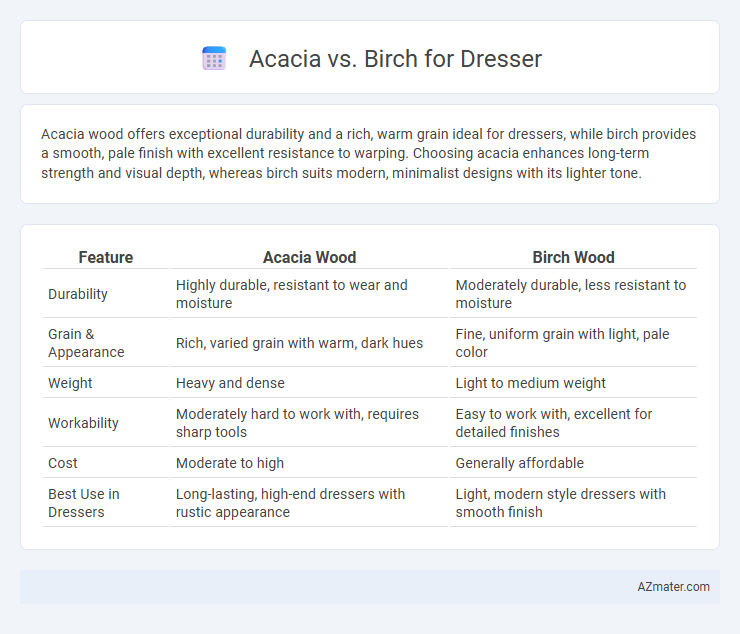Acacia wood offers exceptional durability and a rich, warm grain ideal for dressers, while birch provides a smooth, pale finish with excellent resistance to warping. Choosing acacia enhances long-term strength and visual depth, whereas birch suits modern, minimalist designs with its lighter tone.
Table of Comparison
| Feature | Acacia Wood | Birch Wood |
|---|---|---|
| Durability | Highly durable, resistant to wear and moisture | Moderately durable, less resistant to moisture |
| Grain & Appearance | Rich, varied grain with warm, dark hues | Fine, uniform grain with light, pale color |
| Weight | Heavy and dense | Light to medium weight |
| Workability | Moderately hard to work with, requires sharp tools | Easy to work with, excellent for detailed finishes |
| Cost | Moderate to high | Generally affordable |
| Best Use in Dressers | Long-lasting, high-end dressers with rustic appearance | Light, modern style dressers with smooth finish |
Introduction: Acacia vs Birch for Dressers
Acacia wood is renowned for its rich, warm tones and exceptional durability, making it an excellent choice for dressers that require long-lasting strength and a unique aesthetic. Birch wood offers a lighter, smoother finish with fine grain patterns, appealing to those seeking a sleek and modern look for their bedroom furniture. Both woods provide distinct advantages in terms of appearance and resilience, influencing the overall style and longevity of dressers.
Key Differences Between Acacia and Birch Wood
Acacia wood features a rich, natural grain with dark brown tones and high natural oils that provide excellent water resistance, making it durable for dressers in humid environments. Birch wood, on the other hand, has a lighter, pale yellow color with a smooth, fine grain, prized for its uniform texture and ease of staining to achieve various finishes. While Acacia offers superior hardness and resistance to scratches, Birch is valued for its affordability and workability, ideal for custom dresser designs requiring precise detailing.
Durability: Acacia vs Birch Dressers
Acacia wood dressers are known for their exceptional durability, featuring a dense grain structure that resists scratches and dents better than many hardwoods. Birch dressers offer moderate durability with a fine, uniform grain, but they tend to be softer and more prone to surface damage compared to acacia. For long-lasting furniture that withstands heavy use, acacia dressers generally provide superior strength and resilience over birch.
Appearance and Grain Patterns
Acacia wood features rich, warm hues with varied tones ranging from golden brown to dark reddish brown, displaying bold, irregular grain patterns that create a striking, rustic appearance for dressers. Birch wood, in contrast, offers a lighter, more uniform cream to pale yellow color with subtle, smooth grain patterns that lend a clean, modern look to furniture pieces. The distinct grain textures of Acacia emphasize natural character, while Birch provides a sleek, minimalist aesthetic ideal for contemporary dresser designs.
Weight and Workability Comparison
Acacia wood is denser and heavier than birch, providing a solid and durable dresser that can withstand daily use. Birch is lighter and easier to work with, offering smooth cuts and a fine grain that simplifies sanding and finishing. While acacia's hardness enhances resistance to dents and scratches, birch's superior workability makes it ideal for intricate designs and quicker project completion.
Cost Analysis: Acacia vs Birch
Acacia wood dressers typically cost more than birch due to Acacia's durability, rich grain patterns, and natural resistance to moisture and pests, making it a premium choice for long-lasting furniture. Birch, being a more abundant and softer hardwood, offers a more budget-friendly option without sacrificing too much strength, suitable for cost-effective dressers with a smooth, pale finish. Buyers prioritizing initial investment will find birch dressers more affordable, while those valuing long-term durability and unique aesthetics often prefer the higher upfront cost of Acacia.
Environmental Impact and Sustainability
Acacia wood offers a sustainable option for dressers due to its fast growth rate and ability to thrive in diverse climates, promoting responsible forestry. Birch, sourced primarily from North American forests, supports sustainable practices when harvested through certified programs like FSC, ensuring forest regeneration. Both woods provide durable, eco-friendly choices, but Acacia's resilience to pests and diseases reduces chemical treatments, further minimizing its environmental footprint.
Maintenance and Longevity
Acacia wood dressers require regular oiling and occasional polishing to maintain their natural luster and resist moisture damage, benefiting from their tight grain that makes them more durable and resistant to dents. Birch dressers, while less dense and more prone to scratches, are easier to sand and refinish, though they demand careful protection from water and humidity to prevent warping and discoloration. Both woods offer good longevity, but Acacia's natural oils and hardness provide better long-term resilience with proper upkeep compared to Birch's more delicate surface.
Pros and Cons of Acacia Dressers
Acacia dressers are known for their durability and water resistance, making them an excellent choice for long-lasting furniture with a natural, rich grain pattern that adds warmth to any room. However, Acacia wood can be heavier than Birch, making the dresser less easy to move, and it may cost more due to its exotic appeal and slower growth rate. Compared to Birch, which is lighter and more affordable but less resistant to moisture, Acacia offers superior longevity and aesthetic appeal but requires a higher initial investment and occasional maintenance to preserve its finish.
Pros and Cons of Birch Dressers
Birch dressers offer a smooth, fine grain and a light color that easily complements various interior styles, making them versatile choices for bedroom furniture. Their durability and resistance to warping provide long-lasting functionality, but birch can be more prone to dents and scratches compared to harder woods like acacia. While birch's affordability and ease of staining make it appealing, it lacks the rich, warm hues and natural oil resistance found in acacia, which may impact aesthetic longevity and maintenance.

Infographic: Acacia vs Birch for Dresser
 azmater.com
azmater.com